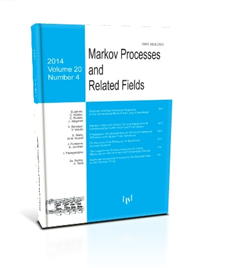Non-Homogeneous Random Walks on a Half Strip with Generalized Lamperti Drifts
Chak Hei Lo, A.R. Wade
2017, v.23, Issue 1, 125-146
ABSTRACT
We study a Markov chain on $\RP \times S$, where $\RP$ is the non-negative real numbers and $S$ is a finite set,
in which when the $\RP$-coordinate is large, the $S$-coordinate of the process is approximately Markov with stationary
distribution $\pi_i$ on $S$. If $\mu_i(x)$ is the mean drift of the $\RP$-coordinate of the process at $(x,i) \in \RP \times S$,
we study the case where $\sum_{i} \pi_i \mu_i (x) \to 0$, which is the critical
regime for the recurrence-transience phase transition. If $\mu_i(x) \to 0$ for all $i$, it is natural to study the \emph{Lamperti\/}
case where $\mu_i(x) = O(1/x)$; in that case the recurrence classification is known, but we prove new results on existence and non-existence
of moments of return times. If $\mu_i (x) \to d_i$ for $d_i \neq 0$ for at least some $i$, then it is natural to
study the \emph{generalized Lamperti\/} case where $\mu_i (x) = d_i + O (1/x)$. By exploiting a transformation which maps
the generalized Lamperti case to the Lamperti case, we obtain a recurrence classification and existence of moments results
for the former. The generalized Lamperti case is seen to be more subtle, as the recurrence classification
depends on correlation terms between the two coordinates of the process.
Keywords: non-homogeneous random walk; recurrence classification; Lyapunov function; Lamperti's problem
COMMENTS
Please log in or register to leave a comment

